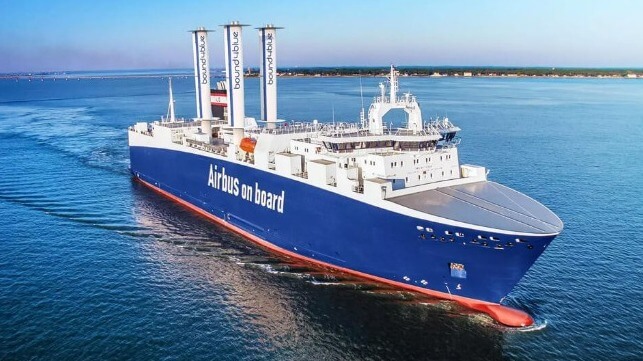Ro-Ro Transporting Assemblies for Airbus to Employ Suction Sails

French shipping company Louis Dreyfus Armateurs working with Airbus, which charters one of its ships, will install suction sails on a Ro-Ro cargo vessel as a test of the technology. According to sail manufacturer bound4blue, it will be the first-ever fixed suction sail installation on a Ro-Ro ship and mark the fourth installation of the technology.
The sails will be fitted aboard the Ville de Bordeaux, a 19-year-old Ro-Ro built in 2004 and operating for Airbus transporting A320 aircraft subassemblies from Europe to Mobile, Alabama for final assembly. The vessel registered in France is 506 feet in length and 5,200 dwt.
“We at Airbus have been studying wind-assisted technologies as a potential energy source for our maritime operations for many years,” said Nicolas Chrétien, Head of Sustainability & Environment at Airbus. “This technology looks promising and we are eager to start testing it in real conditions by the end of the year.”
Three 72-foot-high eSAILs will be fitted to the Ville de Bordeaux ahead of a six-month performance monitoring period starting in early 2024. It consists of a sail-like vertical surface and an electric-powered air suction system that helps the airflow to re-adhere to the sail, generating additional lift and thereby reducing the load on the ship’s main engines therefore delivering savings in fuel consumption and CO2 emissions.
Developed by the Spain-based firm bound4blue, the company asserts that the technology creates as much as six to seven times more lift than a conventional rigid sail. According to bound4blue estimations, these eSAILs could deliver 560 tons of fuel savings annually and reduce CO2 emissions by up to 1,800 tons.
The shipping company Louis Dreyfus Armateurs says that it believes wind-assisted propulsion is one of the solutions to help it reach its goal of achieving net-zero greenhouse gas emissions by 2050. “To determine the best technology for our operations, we are eager to identify and test various forms of wind-assisted propulsion, including rotating vertical cylinders, flexible sails, rigid sails, and wings.”
The installation of eSAILs on the Ville de Bordeaux is co-funded by the European Union.
In a similar effort completed in July, four collapsible sails were installed on the Ro-Ro vessel used to transport components for the European Space Agency. Known as the Canopée, the vessel also sails trans-Atlantic to South America delivering components to the launch site in French Guiana. With the four wings, the ship aims to reduce fuel consumption by on average around 30 percent.
